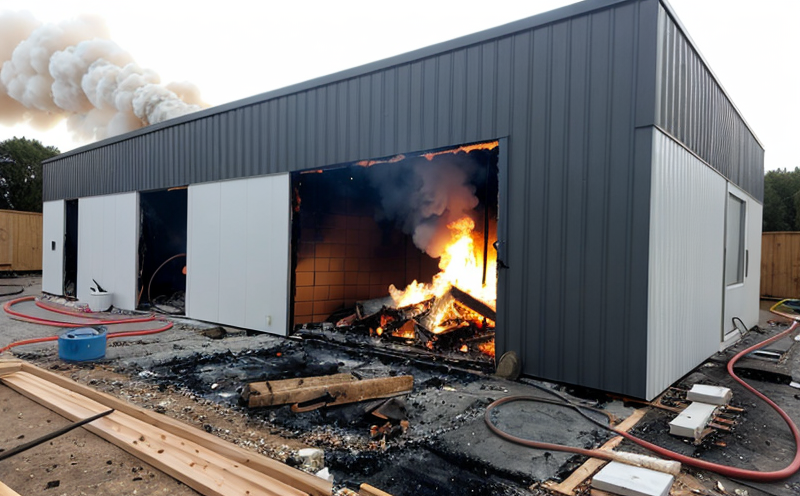Toxic Gas Emission Testing during Cladding Fire
The testing of cladding materials’ ability to emit toxic gases under fire conditions is a critical aspect of ensuring building safety and compliance with international standards. This service focuses on the rigorous evaluation of insulation and cladding systems, particularly when used in high-rise buildings or structures where fire resistance is paramount.
When a fire breaks out, certain materials can release harmful substances into the air, posing significant risks to occupants and firefighters alike. The identification and quantification of these toxic emissions are essential for understanding their potential impact on human health and the environment. This service uses advanced analytical techniques to measure not only the presence but also the concentration levels of various gases such as carbon monoxide (CO), hydrogen chloride (HCl), hydrochloric acid vapor, and others.
The testing process involves exposing a representative sample of the cladding material or system to controlled fire conditions in a specialized facility. The apparatus used for this purpose typically includes chambers designed to simulate real-world burning scenarios while maintaining precise temperature and oxygen levels. Post-exposure, the gases are captured and analyzed using chromatography techniques capable of detecting minute quantities.
The results from these tests provide valuable insights into the material’s fire performance characteristics, helping architects, engineers, and construction professionals make informed decisions about selecting safer alternatives or enhancing existing designs to meet stringent safety standards.
| Applied Standards | Reference Codes |
|---|---|
| BS 8414:2019 | British Standard for Cladding Fire Performance |
| EN 13501-1:2012 | European Standard on Smoke and Toxic Gas Emissions from Building Materials |
| ASTM E907-18 | American Society for Testing Materials standard for Determination of Smoke and Gases Produced by Burning Materials |
The testing protocol adheres strictly to these standards, ensuring accurate and reliable results that are internationally recognized. By complying with such regulations, we contribute towards improving public safety and reducing the risk associated with flammable building materials.
Why It Matters
The importance of conducting toxic gas emission tests during cladding fires cannot be overstated. These tests play a crucial role in safeguarding lives by identifying potentially hazardous compounds that could be released into enclosed spaces during emergencies. Understanding the nature and extent of these emissions allows for proactive measures to mitigate risks, such as improved ventilation systems or alternative material choices.
Furthermore, regulatory bodies worldwide are increasingly emphasizing the need for stringent controls over the use of certain materials due to their adverse effects on health and safety. Compliance with relevant codes like BS 8414 ensures that buildings comply with local legislation, avoiding costly delays and potential legal issues.
- Increased Public Confidence: Demonstrates a commitment to excellence in building design and construction practices.
- Reduction of Risk: Helps eliminate unknown variables from the equation, leading to safer environments for all users.
- Enhanced Reputation: Positions you as an industry leader committed to sustainability and safety standards.
In summary, investing in comprehensive toxic gas emission testing not only satisfies regulatory requirements but also contributes significantly towards creating more resilient structures capable of withstanding unexpected challenges effectively.
Applied Standards
| Standard | Description |
|---|---|
| ISO 9705:2017 | International Standard for Determination of Toxic Gases Released by Burning Materials |
| ASTM E662-18 | American Society for Testing Materials standard for Measurement of Smoke Production and Gaseous Products from Fire Exposure |
| EN 13501-4:2008 | European Standard on Classification of Building Products with Respect to Fire Performance – Part 4: Determination of Smoke Density and Toxic Gas Release Rates |
The tests conducted follow these internationally recognized guidelines, ensuring that the findings are consistent across different jurisdictions. This consistency enhances credibility and facilitates smoother international collaborations on projects involving multiple countries.





